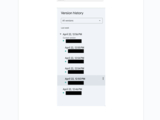Using Google Doc "Versions" to Detect Student Originality vs. AI Abuse
Note: The following tip was shared as part of a 2/18/25 Faculty Development Center workshop, "Encouraging Academic Integrity in the Era of AI." Please feel free to adapt and make it your own.
Given faculty concerns about AI-assisted or even wholly-authored student papers, faculty could use a simple feature in any Google document, spreadsheet or presentation slide: its version history, which includes a summary or detailed date & time stamp of every addition or edit. As such, the goal is not to detect the presence of AI in student writing, which is currently very difficult due to “false positives,” but more so to detect the absence of originality.
Why & How This Might Work
Unlike the iterative, word-by-word or sentence-by-sentence approach of most original writing, students who use AI or plagiarized material are likely copying & pasting entirely ‘in-tact” content as “whole cloth” blocks, perhaps with minimal or even no changes before submitting as a final draft. If so, requiring students to submit a Google Doc for their paper will contain a version history that faculty can inspect. If version 1 – or any version – contains large blocks of text in a short period of time, one can reasonably assume the work is not original. More importantly, if students know that faculty know there’s a version history that can be inspected – and questioned about – maybe they will think twice.
Issues & Opportunities
A student could just try to emulate iterative authorship, copying one word or sentence at a time -- but likely not in a hurry before a deadline, which is the use case most common to plagiarism. Still, the attempt would result in an ironic, self-inflicted penalty, by forcing the student to take time to cheat to appear not to have done so.
Some students may complain that being required to use a Google Doc inhibits their creative writing process or doesn’t show “offline” musings written by hand or in other editors, including notes made on their mobile devices. However, faculty could say the Google Doc version history allows them to to extend the conditions for how students are assessed over time on any assignment vs at the same time (e.g., answering an essay question on an exam). Also, all Google Docs have mobile apps.
For faculty who are ok with students using AI – as an aid to counter writer’s bloc or if clearly cited in the final version – a version history could be a “teachable moment” for how, where and when to do so. Students could be asked to “name” their versions as AI or “mine” or add a comment to explain where and why they changed any AI output.
Suggested Approach
Create a Google Doc template you ask students to copy and use for their written assignment. You could even make this a Google Assignment for submission in a Learning Management System (LMS) like Blackboard.
Tell students you’ll only accept their assignment if you are a named editor/collaborator (you need editing privileges to view a Google Doc’s version history).
Tell students you reserve the right to randomly inspect the version history of any Google Doc they submit as their own work. You can also require an oral interview to have students explain any version.
FYI: A sample syllabus statement on use of AI by students is below (source: John Fritz, DoIT):
Using Google Docs to Detect Students’ AI Usage from East Central College
Prove your writing is not AI-generated by tracking changes in your docs: Showing your work is not just for math problems anymore in Popular Science
With increasing AI plagiarism, write your essays on Google Docs! from Reddit discussion amongst students
Why I Use Google Docs to Teach Writing, Especially in the Age of AI blogpost by Steven D. Krause
How To Use Google Docs Secret Feature to Detect AI Content Writing by Digital Information World
Posted: May 14, 2025, 2:25 PM
